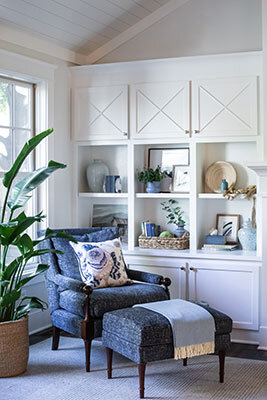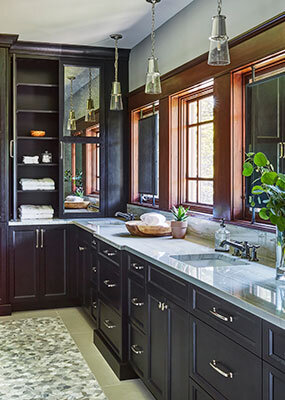Designing a place for everything, so everything can be in its place starts with a lot of questions. Questions about how a family lives and operates within in a home and the ways to keep the items that they use most both convenient and organized. Just as every family has different organization needs, so does every room in the home. To start, we pulled together our top considerations for each space as a guide to help inspire a home to be designed not only aesthetically beautiful, but also organized for functionality.
Kitchens: Thinking about a kitchen in zones can help make sure it is designed with the right organization in the right areas. For instance, can you create a coffee area? Where the coffee maker, your favorite mugs, coffee or tea all live together? Can you keep your pots and pans organized in a drawer conveniently below your cooktop? Laura DeFalco, an expert organizer and owner of Neat Method - Chicago Southwest Suburbs adds, “We like to think of the dishwasher as the heart of your kitchen - constantly loading and unloading. Keep your everyday dishes and glasses close by! As you place items in your kitchen, ask yourself how often you use it. Does this item deserve ‘prime real estate space’ or should it be tucked up higher and out of sight?” How about adding a drawer to dedicate to spices? Alphabetized, of course! Navigating a kitchen that is thoughtfully designed with organization in mind can speed up meal prepping and simplify the dance between storage and cooking.
Family rooms: Built-in cabinets and shelving can do double duty as a place to display favorite treasures, books and pictures on the top and offer hidden storage on the bottom. These bottom cabinets are a great place to tuck away extra blankets, kids toys, DVD's, a pile of magazines to read or seasonal decor. Laura, of Neat Method, reminds us that less is more in the family room - the fewer things out means the fewer things to put away.
Offices: First, think about how you work. Do you spread out papers or, in our case, fabric, tile and paint samples? Do surfaces help with this? Or, do you really just need a laptop? Do you need storage for files? Or, do you keep documents digitally? A Neat Method tip: remember that most items that are filed are rarely touched - be wise about what you decide to file. And, ask, what inspires you in your work? If you turn to books for inspiration, can you store or display them in your office well?
Bathrooms: When designing a bathroom, the storage options are limited by the size of the bathroom. However, even in the smallest bathroom, you can get creative with the cabinet design. With a bottom drawer as tall as a roll of toilet paper, you can keep your stash hidden. Extra drawers are great for keeping small items organized as well. Do children still need a step stool? If so, find a space to either hide the step stool when it is not in use or design a drawer with a step stool pull-out.
Kids rooms: The clutter that can accumulate in a kids room is something else! Making sure they have a place to display their treasures, can help keep the mess contained. Hooks for medals, shelves for lego creations or baskets for stuffed animals help provide some order. Laura advises, “Try to keep kids items to a certain size container or drawer. Once the space is filled, that’s it! Giving a certain amount of space will limit the amount of items.” Also consider their interests and helping with a system where everything has a place. A bookworm may need a bigger bookcase next to a comfy chair. A crafty kid may love a desk with drawers for both a surface to craft and drawers to store supplies. And, since their interests can change, keeping their pieces flexible is always a consideration.
Mudrooms/ laundry rooms: An organized mudroom totally depends on the people who will be using it to come and go from home. Do your kids have devices to charge? A shelf for charging in their lockers or cubbies can keep that device out of your kitchen. Are the kids still growing? If so, a system with hooks that can go up as their coats get longer and they grow taller keeps them from climbing every time they need to hang up their coat (or simply tossing it on the ground!). What are your favorite accessories to grab on the way out the door? Could a drawer for sunglasses or scarves be handy? Make sure there is space for shoes as well. A Neat Method rule is that every family member is only allowed 3 pairs of shoes at a time - all other shoes go into closets. And, what items are helpful to have near the back door? We keep band aids, sunscreen, travel hand sanitizer and tissues handy.
Closets: Start with an inventory of what you have - count all your items! Then, you can work backwards to figure out what you need to outfit your closet with for the best organization. Design your closet system around your shoe collection, love of long dresses or handbag obsession. You may need more shelves or more shoe racks or more tall hanging areas all depending on your wardrobe. One size does not fit all. Make sure you are planning around your specific needs.
By considering ways to keep your family and their favorite things organized from the outset of a project, these features can be designed into a space. It takes asking a lot of questions and thinking through how a space will be used, but it is well worth the advance planning. Sometimes, one of the most beautiful things about a space is how well it functions!













